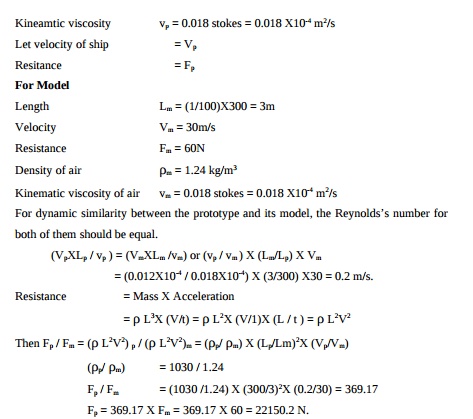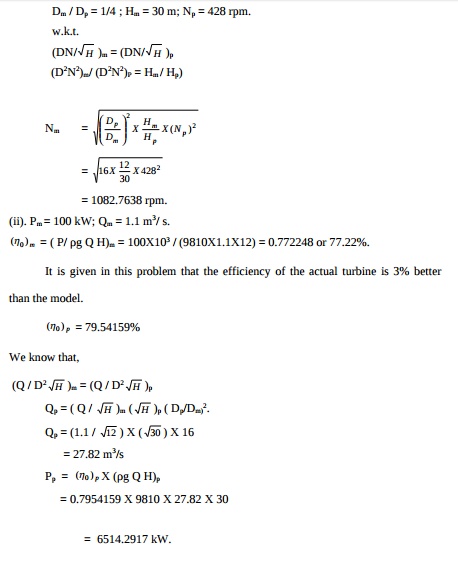Chapter: Civil : Mechanics Of Fluids : Dimensional Analysis And Model Studies
Solved Problems: Civil - Mechanics Of Fluids - Dimensional Analysis And Model Studies
Problem
1
The resisting force of (R)
of a supersonic flight can be considered as dependent upon the length of
aircraft 'l', velocity 'V', air viscosity '?', air density '?', and bulk
modulus of air 'k'. Express the functional relationship between these variables
and the resisting force.
Solution:
Step 1. R = f ( l, V, ?, ?, k ) ? ( R, l, V, ?, ?, k)
= 0
Number of variables, n = 6
Number of primary variable, m = 3
Number of ?
terms
= n - m = 6 - 3 = 3 f (?1, ?2, ?3) = 0
Step
2. Assume l, V and ? to be the repeating variables.
?1 = lx,
Vy, ?z,R
MOLOTO = [ L]X [ LT-1] y
[ML-3]z [MLT-2]

Problem 2
A Ship is 300m long
moves in seawater, whose density is 1030 kg/m3, A 1:100 model of
this to be tested in a wind tunnel. The velocity of air in the wind tunnel
around the model is 30m/s and the resistance of the model is 60N. Determine the
velocity of ship in seawater and also the resistance of the ship in sea water.
The density of air is given as 1.24 kg/m3. Take the Kinematic
viscosity of seawater and air as 0.012 stokes and 0.018 stokes respectively.
Given:
For prototype,
Length Lp
= 300m
Fluid =
Sea water
Density of water = 1030
kg/m3

Problem
3
A 7.2 m height and 15m long spill way
discharges 94 m3/s discharge under a head of 2.0m. If a 1:9 scale
model of this spillway is to be constructed, determine model dimensions, head
over spillway model and the model discharge. If model experience a force of
7500N (764.53Kgf), determine force on the prototype.
Given:
For prototype: height hp = 7.2m
Length, Lp =
15m
Discharge Qp =
94 m3/s
Head, Hp =
2.0m
Size
of model = 1/9. of the size of prototype
Linear scale ratio, Lr = 9
Force
experienced by model Fp = 7500N
Find : (i) Model dimensions i.e., height and
length of model (hm and Lm) (ii). Head over model i.e., Hm
(iii). Discharge through model i.e., Qm (iv).
Force on prototype (i.e., Fp)
(i).
Model dimensions ( hm and Lm )
hp/
hm = Lp/ Lm = Lr = 9
hm = hp / 9 = 7.2 / 9 = 0.8
m Lm = Lp / 9 = 15 / 9 = 1.67 m.
(ii).
Head over model (Hm)
hp/
Hm = Lr = 9
Hm = Hp / 9 = 2/9 = 0.222 m.
(iii). Discharge through model (Qm)
Using
equation we get, Qp / Qm = Lr2.5
Qm = (Qp / Lr2.5)
= 94 / 92.5 = 0.387 m3/s. (iv). Force on the prototype(Fp)
Using
Fr = Fp / Fm = Lr3
Fp
= Fm X Lr3 7500X93 = 5467500N.
Problem
4
A quarter scale turbine model is tested under
a head of 12m. The full-scale turbine is to work under a head of 30m and to run
at 428 rpm. Find N for model. If model develops 100 kW and uses 1100 l/s at
this speed, what power will be obtained from full scale turbine assuming its n
is 3% better than that of model.
Solution
:
Dm / Dp = 1/4 ; Hm = 30 m; Np = 428 rpm.
w.k.t.

Related Topics